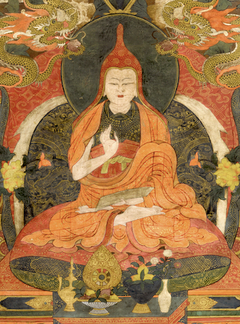Two Kinds of Selflessness
English | Français | Português | Italiano | བོད་ཡིག
Ascertaining the Two Kinds of Selflessness
by Mipham Rinpoche
Homage to Mañjuśrī!
The mind that thinks “I am” in reference to the five aggregates (skandha) of its own psycho-physical continuum is clinging to that “I”. In other words, the referent object (zhen yul) of such clinging is the self of the individual (pudgalātman) or the “I”. As long as we don't investigate or analyse it, we have a sense that this self exists, whereas, in fact, it has never existed, just as there has never been a snake in a length of coloured rope. The five aggregates, which are the basis upon which the self is projected, are themselves multiple and impermanent. We might think that there is a self which endures, in the sense that it came out of the past and will pass into the next phase, and that this self is somehow unitary. Yet such ideas are simply projections, made on the basis of the gathering of the aggregates; and they have no foundation in reality.
The subject, which is the mind that thinks “I am”, is therefore self-clinging. And its referent object is what we call the “self”. Rather like mistaking a length of coloured rope for a snake, we simply project the idea of a self onto the aggregates, while the self in fact has no real existence. Understanding this is the view of selflessness.
All conditioned and unconditioned things other than the "I" or the self are “phenomena” (dharma). As long as we don't subject our naive assumptions to investigation, we believe that these phenomena exist. Yet if we do examine them using logical reasoning, such as the argument of “neither one nor many”, we come to understand that no entity, whether coarse or subtle, can be said to be real. And that understanding of how things lack any basis or origin is what we call the realization of the 'selflessness' (or 'identitylessness') of phenomena (dharmanairātmya).
The self of the individual and the 'self' (or identity) of phenomena are therefore objects of negation: naturally, truly existent individuals and phenomena such as vases. Although we perceive these two kinds of self as a result of our mental delusion, when we analyse them we find that they lack even the slightest hint of reality—and this absence is the selflessness of the individual and of phenomena. The mind that understands the absence of self in this way is said to realize selflessness.
There are thus two forms of perceived self, and correspondingly two types of subject, or self-clinging. In order to eradicate both forms of self-clinging, it is necessary to arrive at certainty through logical reasoning, by considering how these two types of object, or types of self, lack true existence, and thereby generating realization of selflessness within the mind, as the 'subject' perceiving twofold selflessness.
In short, clinging to an “I” is the source of all mental afflictions (kleśa), which are the root of saṃsāra. Its antidote is the realization of individual selflessness, which is like the root of the path to liberation. And the full view of emptiness, through which we understand how all phenomena lack true existence, overcomes cognitive obscurations in their entirety—and is thus the root of the Mahāyāna path. Until we arrive at a deep, stable certainty concerning the great equality that is the inexpressible dharmadhātu, in which emptiness and dependent origination are indivisible, we must continue to refine our view.
Mere conceptual understanding based on an unqualified negation (med dgag)—i.e., refuting an object of negation—is the 'categorizable ultimate' (rnam grangs pa'i don dam), which is merely a gateway to true, ultimate reality, not the ultimate nature itself.
The Middle Way of unlimited unity, or the 'uncategorizable ultimate' (rnam grangs ma yin pa'i don dam), is the natural state of the indivisibility of the two truths, which is understood through self-knowing awareness, and is characterised by pacification of web-like conceptual elaboration.
In short, conceptual understanding born of analysis brings genuine certainty and the decisive understanding that all the phenomena of saṃsāra and nirvāṇa appear while lacking even so much as an atom's worth of true existence—as is made clear when we subject them to investigation and analysis. Moreover, there is no conflict between the appearance of all these entities and their lack of true existence, just as in the examples of the reflection of the moon in water, a dream, or an illusion. Conviction at this stage is equivalent to the certainty regarding illusoriness that is experienced during post-meditation. Although it represents a positive intellectual grasp of Madhyamaka, by itself it does not qualify as seeing the true dharmadhātu, the great Middle Way beyond conceptual elaboration, which must be understood through self-knowing awareness. We must therefore engender a special form of certainty within the space-like freedom from conceptual elaboration that results from directly seeing the actual state of inexpressible unity. Then we must practise the meditative equipoise in which all philosophical standpoints based on thoughts of refutation or proof have faded away entirely. This is said to mark the point at which an analytical view developed through study and reflection is perfected. Still, the dharmadhātu, which is an object of self-knowing awareness, can only be seen through the complete transcendence of ordinary mental processes, and not through any outwardly directed, language-based analysis which fails to strike the crucial point. Moreover, those who are adept at settling the mind as a result of their guru's pith instructions, find it easy to develop certainty. We must therefore understand the key points of the path without error.
By Mipham.
| Translated by Adam Pearcey, 2016
Bibliography
Tibetan Text
mi pham rgya mtsho. "bdag med gnyis gtan la 'bebs tshul/" in gsung 'bum/_mi pham rgya mtsho. 27 vols. Paro, Bhutan: Lama Ngodrup and Sherab Drimey, 1984–1993. Vol. 27: 19–22
Version: 1.2-20220221
